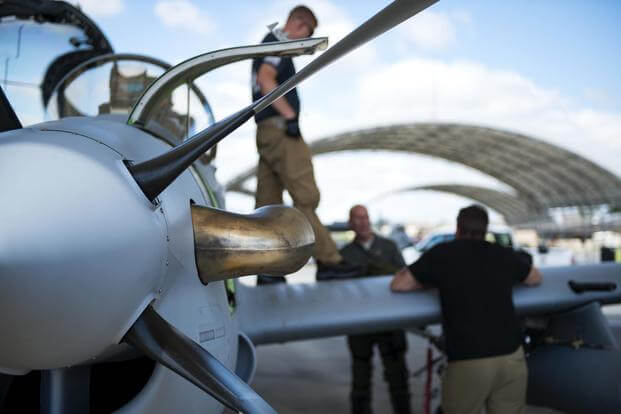The Air Force has canceled the remaining flying portions of its light attack experiment at Holloman Air Force Base, New Mexico, following a recent A-29 Super Tucano crash that killed a Navy pilot, officials announced Tuesday.
"The Air Force has decided to conclude the flying portion of the light attack experiment," Lt. Gen. Arnold Bunch, top acquisition official for the service, told reporters during a briefing at the Pentagon.
The demonstration day, originally scheduled for July 19 with more than 50 international partners expected to attend, will be rescheduled for a later time, he said.
"Our number one priority right now is supporting the Safety Investigation Board," Bunch said. "We analyzed where we were with the flying portions that we had done, and we decided that we had enough data [without additional flights]."
Officials last week announced the experiment, dubbed OA-X, was on hold in the wake of the fatal mishap. Lt. Christopher Carey Short, of Canandaigua, New York, was piloting the A-29 when it crashed over the Red Rio Bombing Range within White Sands Missile Range, New Mexico, on June 22. At the time of the crash, two pilots were onboard. The second pilot sustained minor injuries and was airlifted to a hospital.
Related content:
- Senators Want $100 Million for New Marine Corps Light Attack Aircraft
- From Old Pilots to New Planes, Air Force Chief Talks 'New Ways of Doing Business'
- Air Force Light Attack Demo Halted in Wake of Fatal A-29 Accident
The safety board is now investigating the cause of the crash, and will produce internal results within 30 days, Bunch said. Should an additional investigation be needed, an Accident Investigation Board report will not be released for some months, he added.
Bunch said the service will continue to work with defense industry partners to complete any remaining test requirements, mostly maintenance and sustainment data.
"In the network, we got quite a bit of experimentation done in that area," he said.
One goal of the OA-X effort is to stand up a fleet of aircraft that could connect into a network of shareable information with allies and partners already flying light air support craft.
If the planes can be interoperable with other militaries’ planes, the result would be a diverse fleet of aircraft with partners across the world, officials have said.
With that in mind, Bunch said the service is working to export and grow its network experimentation onto another aircraft -- potentially another Air Force aircraft or a completely different light attack platform -- to test the additional capability.
"We experiment all the time," he said. "We're still going to experiment and try out the network in other areas over time. The goal of this network is to get it to the point where we can utilize it in other platforms beyond light attack."
Test units at Holloman were conducting Phase II of the Air Force's light attack experiment, part of the service's effort to procure a new fleet of lightweight, inexpensive aircraft. After Phase I was completed in August, the Air Force selected two aircraft -- the Textron Aviation AT-6 Wolverine and the Sierra Nevada/Embraer A-29 Super Tucano -- to undergo more demonstration fly-offs, among other tests, at Holloman.
The Air Force has not committed to making light attack a program of record even as lawmakers are hopeful the light attack aircraft procurement strategy may improve how future weapons systems are acquired.
In November, key lawmakers agreed to provide the Air Force with $400 million to continue experimenting with the planes.
Bunch said a potential request for proposal could be issued by December.
"If we decide that we're going to go forward with the acquisition ... if that's the direction we're going to go, we want to get an RFP out on the street by December," he said. "If we go down that path ... what we then want to do is make a downselect decision within the next fiscal year."
Bunch said a future competition is likely to be between the AT-6 and A-29, given the two aircraft were selected to continue into Phase II of the exercise.
"I'm seeing it as a competition between the two airplanes," he said.
While discussing light attack last week, Gen. Mike Holmes, head of Air Combat Command, said he was not worried the recent crash would negatively impact the demo, or future aircraft experiments.
Bunch on Tuesday agreed with the assessment but added that it still gave leaders pause.
"Anytime you lose a [service member], you have to pause and think a little bit about where we're at," he said. "The loss of Lt. Short is a critical setback for America writ large. That is a big hit to all of us. Having said that, we were trying a different approach. We believe we've collected the data using that approach, and I would see us using approaches similar to this in the future."
-- Oriana Pawlyk can be reached at oriana.pawlyk@military.com. Follow her on Twitter at @Oriana0214.












